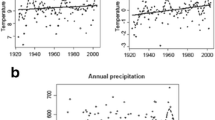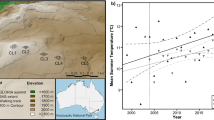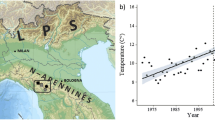Abstract
In response to climate warming, high altitude alpine vegetation may be replaced by typically lower altitude species, as species re-assemble and migrate to new areas. However, empirical evidence showing vegetation change in response to climate warming is largely unavailable for Australian alpine areas. Here, we examine changes in species richness with respect to climate and altitude over a 7 year period at a range of spatial scales in a re-survey of five alpine summits that are part of the Global Observation Research Initiative in Alpine Environments monitoring network. Eighty species were recorded in 2011 across all summits, an increase of 6 species since 2004. Mean species richness increased at the whole-of-summit scale from 45 to 50 species (about 12 %). At this scale, the rate of species richness increase was almost one new species per year, with 15 new species recorded at one summit. Here, shrub and graminoid species showed the largest increases. At the smaller spatial scales, changes in species richness were less pronounced. Turnover at the species and community level was typically moderate at all spatial scales and on all summits. The strength and direction of species richness change (the difference in species richness between the two sample periods, +/−) was not related to altitude nor variation in climate. Future re-surveys of the summits will confirm whether these short-term variations in species richness, particularly increases in shrubs, are indeed signals of longer-term trends and interactions with a changing climate.



Similar content being viewed by others
References
Bahn M, Körner C (2003) Recent increases in summit flora caused by warming in the Alps. In: Nagy L, Grabherr G, Körner C, Thompson DBA (eds) Alpine biodiversity in Europe. Springer, Berlin, pp 437–441
Böhm R, Auer I, Brunetti M, Maugeri M, Nanni T, Schöner W (2001) Regional temperature variability in the European Alps: 1760–1998 from homogenized instrumental time series. Int J Climatol 21:1779–1801
Buckeridge KM, Zufelt E, Chu H, Grogan P (2010) Soil nitrogen cycling rates in low arctic shrub tundra are enhanced by litter feedbacks. Plant Soil 330:407–421
Callaway RM (1995) Positive interactions among plants. Bot Rev 61(4):306–349
Callaway RM, Brooker RW, Choler P, Kikvidze Z, Lortie CJ, Newingham B, Aschehoug ET, Armas C, Kikodze D, Cook BJ (2002) Positive interactions among alpine plants increase with stress. Nature 417:844–848
Cavieres LA, Badano EI, Sierra-Almeida A, Gómez-González S, Molina-Montenegro MA (2006) Positive interactions between alpine plant species and the nurse cushion plant Laretia acaulis do not increase with elevation in the Andes of central Chile. New Phytol 169(1):59–69
Choler P, Michalet R, Callaway RM (2001) Facilitation and competition on gradients in alpine plant communities. Ecology 82:3295–3308
Costin AB (1954) A study of the ecosystems of the Monaro region of New South Wales with special reference to soil erosion. Soil Conservation Service of New South Wales, Sydney
Costin AB, Gray M, Totterdell CJ, Wimbush DJ (2000) Kosciuszko alpine flora, 2nd edn. CSIRO, Melbourne
Crimmins SM, Dobrowski SZ, Greenberg JA, Abatzoglou JT, Mynsberge AR (2011) Changes in climatic water balance drive downhill shifts in plant species’ optimum elevations. Science 331:324–327
Dirnböck T, Dullinger S (2004) Habitat distribution models, spatial autocorrelation, functional traits and dispersal capacity of alpine plant species. J Veg Sci 15(1):77–84
Dullinger S, Dirnböck T, Grabherr G (2003) Patterns of shrub invasion into high mountain grasslands of the northern Calcareous Alps, Austria. Arct Antarct Alp Res 35(4):434–441
Dullinger S, Gattringer A, Thuiller W, Moser D, Zimmermann NE, Guisan A, Willner W, Plutzar C, Leitner M, Mang T, Caccianiga M, Dirnböck T, Siegrum E, Fischer A, Lenoir J, Svenning J-C, Psomas A, Schmatz DR, Silc U, Vittoz P, Hülber K (2012) Extinction debt of high mountain plants under twenty-first century climate change. Nat Clim Change. doi:10.1038/NCLIMATE1514
Edmonds T, Lunt ID, Roshier DA, Louis J (2006) Annual variation in the distribution of summer snowdrifts in the Kosciuszko alpine area, Australia, and its effect on the composition and structure of alpine vegetation. Austral Ecol 31:837–848
Engler R, Randin C, Thuiller W, Dullinger S, Zimmermann NE, Araújo MB, Pearman PB, Le Lay G, Piédallu C, Albert CH, Choler P, Coldea G, de Lamo X, Dirnböck T, Gégout J-C, Gómez-García D, Grytnes J-A, Heegaard E, Høistad F, Nogués-Bravo D, Normand S, Pucas M, Sebastià MT, Stanisci A, Theurillat J-P, Trivedi M, Vittoz P, Guisan A (2011) 21st climate change threatened European mountain flora. Glob Change Biol 17:2330–2341
Erschbamer B, Unterluggauer P, Winkler E, Mallaun M (2011) Changes in plant species diversity revealed by long-term monitoring on mountain summits in the Dolomites (northern Italy). Preslia 88:387–401
Gottfried M, Pauli H, Futschik A, Akhalkatsi M, Barancok P, Benito Alonso JL, Coldea G, Dick J, Erschbamer B, Fernandez Calzado MR, Kazakis G, Krajci J, Larsson P, Mallaun M, Michelsen O, Moiseev D, Moiseev P, Molau U, Merzouki A, Nagy L, Nakhutsrishvili G, Pedersen B, Pelino G, Puscas M, Rossi G, Stanisci A, Theurillat J-P, Tomaselli M, Villar L, Vittoz P, Vogiatzakis I, Grabherr G (2012) Continent-wide response of mountain vegetation to climate change. Nat Clim Change 2:111–115
Grabherr G, Gottfried M, Pauli H (1994) Climate effects on mountain plants. Nature 369(9):448
Grabherr G, Gottfried M, Gruber A, Pauli H (1995) Patterns and current change in alpine plant diversity. In: Chapin FS, Körner C (eds) Arctic and alpine biodiversity: patterns, causes and ecosystem consequences. Springer, Berlin, pp 167–181
Green K (2010) Alpine taxa exhibit differing responses to climate warming in the Snowy Mountains of Australia. J Mt Sci 7:167–175
Green K, Pickering CM (2009) The decline of snowpatches in the Snowy Mountains of Australia: importance of climate warming, variable snow and wind. Arct Antarct Alp Res 41:212–218
Guisan A, Theurillat J-P (2000) Assessing alpine plant vulnerability to climate change: a modelling perspective. Integr Assess 1:307–320
Hennessey K, Whetton P, Smith I, Bathols J, Hutchinson M, Sharples J (2003) The impact of climate change on snow conditions in mainland Australia. CSIRO Atmospheric Research, Aspendale
Hoffmann AA, Camac JS, Williams RJ, Papst W, Jarrad FC, Wahren C-H (2010) Phenological changes in six Australian subalpine plants in response to experimental warming and year-to-year variation. J Ecol 98:927–937
Holzinger B, Hüber K, Camenisch M, Grabherr G (2008) Changes in plant species richness over the last century in the eastern Swiss Alps: elevational gradient, bedrock effects and migration rates. Plant Ecol 195:179–196
Hughes L (2003) Climate change and Australia: trends, projections and impacts. Austral Ecol 28(4):423–443
Klanderud K, Birks HJB (2003) Recent increases in species richness and shifts in altitudinal distributions of Norwegian mountain plants. Holocene 13(1):1–6
Körner C (1992) Response of alpine vegetation to global climate change. Catena 22:85–96
Körner C, Larcher W (1988) Plant life in cold climates. Symp Soc Exp Biol 42:25–57
Körner C (2003) Alpine plant life, 2nd edn. Springer, Berlin
Kullman L (2002) Rapid recent range-margin rise of tree and shrub species in the Swedish Scandes. J Ecol 90:68–77
Laurance WF, Dell B, Turton SM, Lawes MJ, Hutley LB, McCallume H, Dale P, Bird M, Hardyb G, Prideaux G, Gawneg B, McMahond CR, Yuh R, Hero J-M, Schwarzkopf L, Krockenberger A, Setterfield SA, Douglas M, Silvester E, Mahonyl M, Vellam K, Saikia U, Wahren C-H, Xue Z, Smith B, Cocklin C (2011) The 10 Australian ecosystems most vulnerable to tipping points. Biol Conserv 144:1472–1480
Lenoir J, Gégout JC, Marquet PA, P. dR, Brisse H (2008) A significant upward shift in plant species optimum elevation during the 20th century. Science 320:1768–1771
Lesica P, McCune B (2004) Decline of arctic-alpine plants at the southern margins of their range following a decade of climatic warming. J Veg Sci 15(5):679–690
Lesica P, Steele BM (1996) A method for monitoring long term population trends: an example using rare arctic-alpine plants. Ecol Appl 6:879–887
McDougall KL (2003) Aerial photographic interpretation of vegetation changes on the Bogong High Plains, Victoria, between 1936 and 1980. Aust J Bot 51:251–256
McDougall KL, Brookhouse MT, Broome LS (2012) Dendroclimatological investigation of mainland Australia’s only alpine conifer, Podocarpus lawrencei Hook.f. Dendrochronologia 30:1–9
Milberg P, Hansson ML (1993) Soil seed bank and species turnover in a limestone grassland. J Veg Sci 4:35–42
Moiseev PA, Shiyatov SG (2003) Vegetation dynamics at the treeline ecotone in the Ural highlands, Russia. Alpine biodiversity in Europe. In: Nagy L, Grabherr G, Körner C, Thompson DBA (eds) Alpine biodiversity in Europe—a Europe-wide assessment of biological richness and change. Ecological studies, vol 167. Springer, Berlin, pp 423–435
Myers-Smith IH, Forbes BC, Wilmking M, Hallinger M, Lantz T, Blok D, Tape KD, Macias-Fauria M, Sass-Klaassen U, Lévesque E, Boudreau S, Ropars P, Hermanutz L, Trant A, Collier LS, Weijers S, Rozema J, Rayback SA, Schmidt NM, Schaepman-Strub G, Wipf S, Rixen C, Ménard CB, Venn S, Goetz S, Andreu-Hayles L, Elmendorf S, Ravolainen V, Welker J, Grogan P, Epstein HE, Hik DS (2011) Shrub expansion in tundra ecosystems: dynamics, impacts and research priorities. Environ Res Lett 6(4):045509
Nicholls N (2005) Climate variability, climate change and the Australian snow season. Aust Meteorol Mag 54:177–185
Pauli H, Gottfried M, Grabherr G (2003a) The Piz Linard (3411 m), the Grisons, Switzerland—Europe’s oldest mountain vegetation study site. In: Nagy L, Grabherr G, Körner C, Thompson DBA (eds) Alpine biodiversity in Europe—a Europe-wide assessment of biological richness and change. Ecological studies, vol 167. Springer, Berlin, pp 443–448
Pauli H, Gottfried M, Dirnböck T, Dullinger S, Grabherr G (2003b) Assessing the long-term dynamics of endemic plants at summit habitats. In: Nagy L, Grabherr G, Körner C, Thompson DBA (eds) Alpine biodiversity in Europe—a Europe-wide assessment of biological richness and change. Ecological studies, vol 167. Springer, Berlin, pp 195–207
Pauli H, Gottfried M, Hohenwallner D, Reiter K, Casale R, Grabherr G (2004) The GLORIA field manual—multi-summit approach. European Commission DG Research, EUR 21213, Office for Official Publications of the European Communities, European Commission, Luxembourg
Pauli H, Gottfried M, Reiter K, Klettner C, Grabherr G (2007) Signals of range expansions and contractions of vascular plants in the high Alps: observations (1994–2004) at the GLORIA master site Schrankogel, Tyrol, Austria. Glob Change Biol 13(1):146–156
Pauli H, Gottfried M, Dullinger S, Abdaladze O, Akhalkatsi M, Alonso JLB, Coldea G, Dick J, Erschbamer B, Calzado RF, Ghosn D, Holten JI, Kanka R, Kazakis G, Kollar J, Larsson P, Moiseev P, Moiseev D, Molau U, Mesa JM, Nagy L, Pelino G, Puscas M, Rossi G, Stanisci A, Syverhuset AO, Theurillat J-P, Tomaselli M, Unterluggauer P, Villar L, Vittoz P, Grabherr G (2012) Recent plant diversity changes on Europe’s mountain summits. Science 336:353–355
Pickering CM, Green K (2009) Vascular plant distribution in relation to topography, soils and micro-climate at five GLORIA sites in the Snowy Mountains, Australia. Aust J Bot 57:189–199
Pickering CM, Hill W, Green K (2008) Vascular plant diversity and climate change in the alpine zone of the Snowy Mountains, Australia. Biodivers Conserv 17:1627–1644
Scherrer P (2003) Monitoring vegetation change in the Kosciuszko alpine zone, Australia. PhD thesis, Griffith University, Gold Coast
Scherrer P, Pickering CM (2005) Recover of alpine vegetation from grazing and drought: data from long-term photoquadrats in Kosciuszko National Park, Australia. Arct Antarct Alp Res 37(4):574–584
Theurillat J-P, Guisan A (2001) Potential impact of climate change on vegetation in the European Alps: a review. Clim Change 50:77–109
Venn SE (2007) Plant recruitment across alpine summits in south-eastern Australia. PhD thesis, La Trobe University, Melbourne
Venn SE, Morgan JW (2005) Patterns in alpine vegetation across an altitudinal gradient in Victoria, Australia: an example of ‘space for time substitution’ in order to assess the potential effects of climate change. In: Price MF (ed) Global change in mountain regions. Sapiens Publishing, Duncow
Venn SE, Morgan JW (2009) Patterns in alpine seedling emergence and establishment across a stress gradient of mountain summits in south-eastern Australia. Plant Ecol Divers 2(1):5–6
Venn SE, Morgan JW (2010) Soil seedbank composition and dynamics across alpine summits in south-eastern Australia. Aust J Bot 58:349–362
Venn SE, Morgan JW, Green PT (2009) Do facilitative interactions with neighboring plants assist the growth of seedlings at high altitudes in alpine Australia? Arct Antarct Alp Res 41(3):381–387
Venn SE, Green K, Pickering CM, Morgan JM (2011) Using plant functional traits to explain community composition across a strong environmental filter in Australian alpine snowpatches. Plant Ecol 212:1491–1499
Vittoz P, Bayfield N, Brooker R, Elston DA, Duff EI, Theurillat J-P, Guisan A (2010) Reproducibility of species lists, visual cover estimates and frequency methods for recording high-mountain vegetation. J Veg Sci 21(6):1035–1047
Walther G-R, Beißner S, Burga CA (2005) Trends in the upwards shift of alpine plants. J Veg Sci 16:541–548
Wearne LJ, Morgan JW (2001) Floristic composition and variability of subalpine grasslands in the Mt Hotham region, north-eastern Victoria. Aust J Bot 49:721–734
Zobel MM, Otsus JL, Moora M, Möls T (2000) Is small-scale species richness limited by seed availability or microsite availability. Ecology 81:3274–3282
Acknowledgments
This project was supported by the Australian Alps Liaison Committee, the National Climate Change and Adaptation Research Facility and the New South Wales National Parks and Wildlife Service. Sarah Butler, Nicole Beutel, Rochelle Steven and Craig Hyde assisted with fieldwork. Special thanks go to Georg Grabherr and the GLORIA Vienna team. Sarah Butler commented on early versions of the manuscript. We also thank two anonymous referees for their valuable and insightful comments and suggestions.
Author information
Authors and Affiliations
Corresponding author
Rights and permissions
About this article
Cite this article
Venn, S., Pickering, C. & Green, K. Short-term variation in species richness across an altitudinal gradient of alpine summits. Biodivers Conserv 21, 3157–3186 (2012). https://doi.org/10.1007/s10531-012-0359-2
Received:
Accepted:
Published:
Issue Date:
DOI: https://doi.org/10.1007/s10531-012-0359-2




